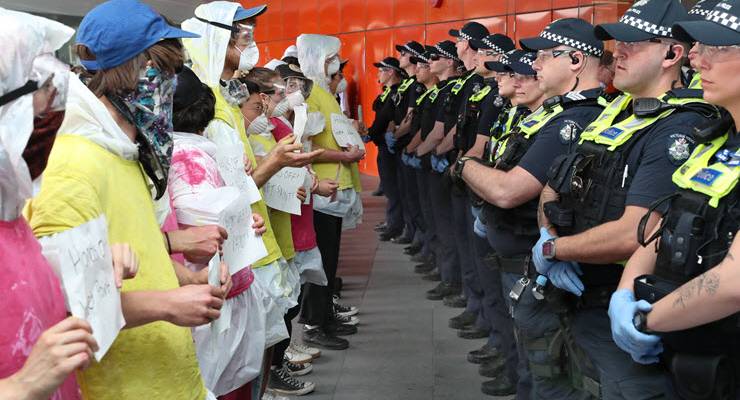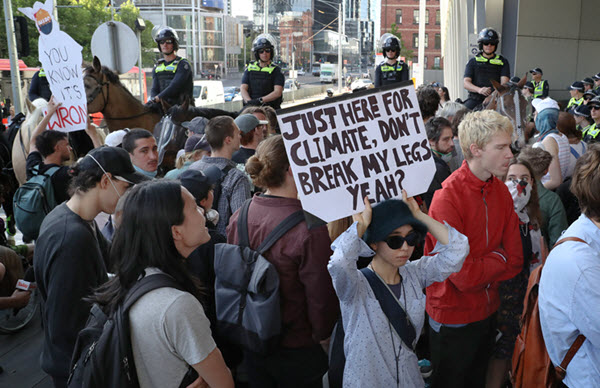
When you’ve been going to demonstrations as a participant and observer for 35 years, there’s an urge to write them up as a minor counties cricket matches. This is only inhibited by the fact that some people are still washing pepper spray out of their eyes, and worse.
So I won’t say that this week the Protesters Combined squared off against the Policepersons Gentlemen’s Eleven in a three-innings stoush in front of the International Mining and Resources Conference (IMARC) at the Melbourne Convention Centre. Cops put the protesters into bat on Monday, trying to blockade the whole thing — not doable with about 300 protesters, though the point was made. Put back into bat for day two after low-run yields, the protesters acquitted themselves ably by non-violently surrounding the various suits going in and out, and berating them.
The protesters were assisted by several delegates who had a clear exit ’round the back — which was why the blockade wasn’t cleared — but decided to tackle the line anyway. This didn’t thrill the cops, who left a few of them stuck amid an angry crowd for a precious few seconds. That detail seems to have fallen out of the mainstream news reports for some reason.
All good vigorous direct democracy, but on day three the cops went in hard, riding horses — they had about six there, including a heartbreakingly pretty all-white one — and using pepper spray. The effort to overhaul the protesters fell short, I’d say, with the cops losing their cool and command.
Given the current cultural-moral climate, one wonders how much longer horses can be used for this sort of thing. Confronting as it is to have one rear up in front of you, it’s always obvious how much more terrified the horse is. How much longer can we torment these poor dumb animals? And not just the anarchists. I’m worried about the horses too. Mind you, be careful what you wish for. If not horses it’ll be armoured vehicles and water cannons, in our great state of whatever this government is.
But, yes, it’s the protesters on points so far, with one day to go.

The protest made the conference a contested, street-fought event, far from the smooth consensual affair the organisers wanted it to be. The mainstream news, condemning it editorially, had a commercial interest in bigging it up. Some tight shooting made it look like the whole area was filled with protesters (and got a couple of crews and journos biffed, which never helps the cops’ cause).
The effort was all the more impressive for a smallish turnout of about 300-400 — a product perhaps of the Extinction Rebellion week previously, warnings of crackdowns, and some debate within the movement as to whether a protest targeting all mining was good politics, given that we are going to need, well, minerals.
But no one’s blockading a metallurgists’ conference. IMARC wasn’t a studious reflection on mining methods and outcomes. It was a festival of extractivism, a gleeful gathering to conspire in our more rapid extinguishment. By the latter part of this century, that whole area of Melbourne will have to be abandoned, put on stilts, or put behind a retaining wall so vast (and probably unfeasible) as to wall us off from the bay entirely.
Contrary to what some blimpish commentators said, the nihilism and anarchy was taking place inside the building, which was being besieged by civilisation. More power to those who turned out for a tough match and put their bodies on the line. The government — especially an ostensibly social democratic one — better decide where it’s going to stand on these things.
The object, going all the way back to the anti-nuclear ships protests of the ’80s, is to make Melbourne losing territory for climate destroyers, the war machine, fascists and the rest. You won’t win in Melbourne, even on the Duckworth-Lewis system. As the crisis intensifies, there will be more and bigger protests to come.
And they won’t be cricket.








“Don’t stand so close to me…….”
Did The Police Boycott their innings – play a dead bat?
Yes. We quiet Australians don’t need Morrison to talk for us. We do have our own voice.
Mind you, I don’t think he will like what we have to say.
However; the Andrews government needs to get its act together, too. Otherwise it’s facing a huge swing to the Greens at the next election. Which mightn’t be a bad thing: I’m starting to lose faith in Labor’s social conscience.
Gotta keep the tabloids at bay Graeski. And the brekky tv nongs – on both sides of the screen.
Congratulations to all those proving again that there’s no substitute for feet on the ground disturbing our complacency. Real change will never come via Facebook.
“Contrary to what some blimpish commentators said, the nihilism and anarchy was taking place inside the building, which was being besieged by civilisation. ”
Nailed it Guy!
“By latter part of this century . . . . or put behind a retaining wall so vast . . . . as to wall us off from the bay entirely.”
Guy’s observations, both broad canvas and detail. Protests more and more common.
Is it fair to reflect a physical world forcing need of change. One of our adapting to a future, vastly different world. A natural world of competitive priorities. A world stretching boundaries of acceptability. Of peoples driven to contest; to survive? Most of us probably thinks Climate threat sucks. But more and more of us think it’s not going to go away . . . is it? And if parliaments, politicians, law and order officers don’t, can’t change/adapt? Well, new means, responses, structures and authorities best suited; must be found. Don’t they?
Nice piece Guy, thanks.
I was there today – rather subdued I think – to continue the metaphor, everyone now knew it would be a draw.
It struck me very strongly that the Police should have been facing the criminals inside the building and protecting the rest of us from them.
As you suggest, there isn’t a lot of subtlety in shouting at random delegates that they have blood on their hands; for all we know, some might be mining the lithium we need for storage batteries. But then there isn’t much subtlety in a rapidly disintegrating planet either.
Finally, I too am bewildered at why we have mounted police at these events. I assume it is just for a stupid show of strength. But the horses are totally unsuited to this work, and the risk to them, their riders, the protesters and passers-by seems very high. I know the mounted police are really caring of their horses, so I’m sure the situation is very frightening for them too.